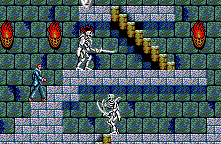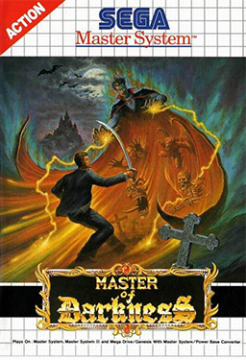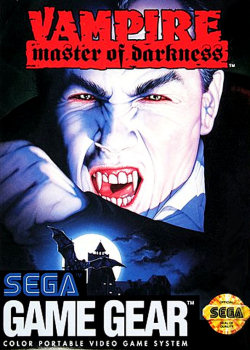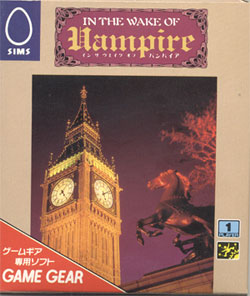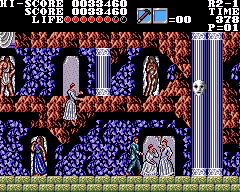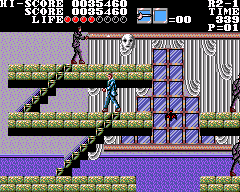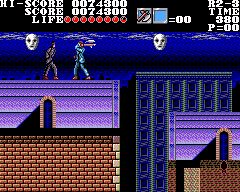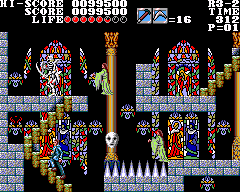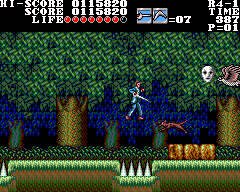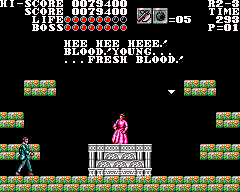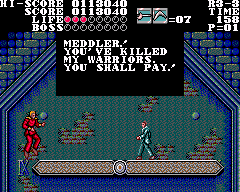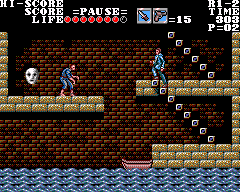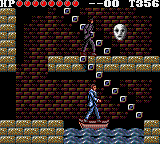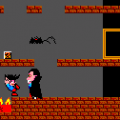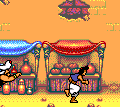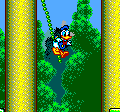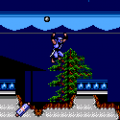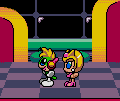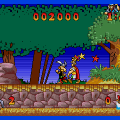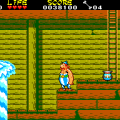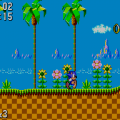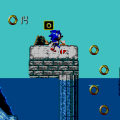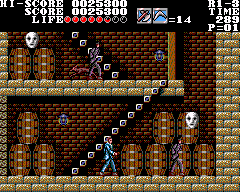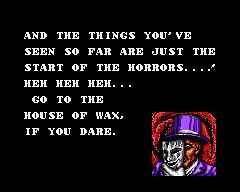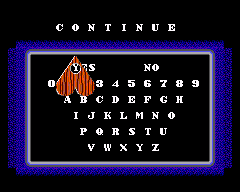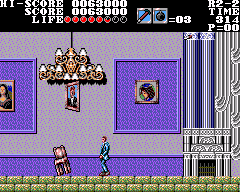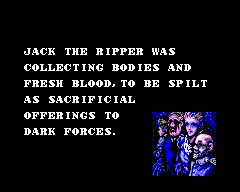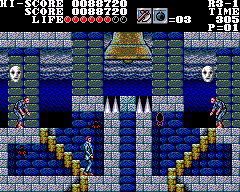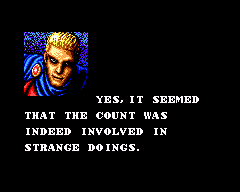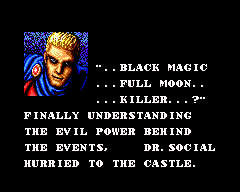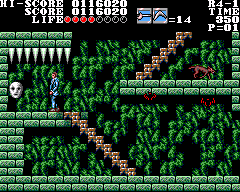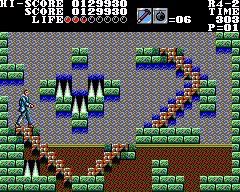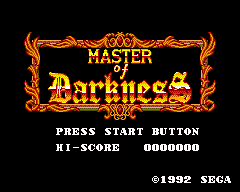One look at Vampire: Master of Darkness (or In the Wake of Vampire, depending on which version you’re playing) and it’s incredibly clear that it’s a shameless Castlevania clone. The setting is a bit different, at least. Taking place in London around the time of Bram Stoker’s Dracula novel, you control Dr. Ferdinand Social, who begins investigating the murders of Jack the Ripper, only to discover that they’re actually the work of a vampire. His investigation leads him on a vampire hunting quest all across England to kill the perpetrator.
The basic level design is more or less exactly like Castlevania, with many platforms connected by stairways, and levels filled with an assortment of zombies, bats, ghosts, skeletons, and possessed furniture. Power-ups are hidden by floating masks, rather than candles. Some of the locales are original compared to the Castlevania games that were out at the time, like the foggy London streets in the opening stage, or the wax museum that serves as a haunted house, but by the time you climb the chapel and jump on swinging pendulums in the clock tower, it’s clear some folks at SIMS, the developer, desperately wanted to be working for Konami instead.
There are a few other small tweaks, most of which are welcome. Brief story scenes after each stage do the minimum to create context for the quest. Dr. Social is a little easier to control than his Belmont counterparts, as he can actually change direction in mid-air, and even jump off stairs (though not on them). Some stages have small branching paths, or at least extra areas you can find for bonus power-ups. The final level is a non-linear labyrinth, which is a huge pain to explore but at least helps set it apart.
The biggest issue with Master of Darkness isn’t its blatant plagiarism, but rather its lack of understanding of why Castlevania was such an outstanding game in the first place. The rhythm of the character and enemy movements in Castlevania were so perfectly calculated that, once you got the timing down, dispatching most enemies wasn’t particularly difficult. There is no such emphasis placed into the design of Master of Darkness. Enemies attack quickly and unpredictably, especially the infernal bats, which are difficult to see, much less even hit. Moreover, many foes take two hits to kill, requiring perfect timing of follow-up hits.
The only reason why the game isn’t completely unplayable is that you can take an incredible amount of damage. The health bar consists of ten red orbs, and many enemies only drain half an orb, some even less. The result is a game that feels sloppy, as you hobble through levels, trying to minimize damage from enemies that are nearly impossible to hit consistently, until you get a health power-up or complete the stage. The stages, split up into three smaller levels, tend to meander longer than they should, particularly the areas where you get locked in a room and need to defeat respawning enemies until the game gets sick of throwing them at you.
There are four main weapons – the default knife, an axe, a fencing sword and a cane. The knife has such a short length that it’s almost entirely useless, and replacement weapons aren’t as common as they should be. Moreover, new weapons don’t work on a linear power-up progression scale – you can have a sword one moment, then accidentally pick up a knife and end up in a crippled state. The subweapons, throwing bombs and boomerangs – help close the distance gap between your character and the enemy, and are useful in boss fights, but are otherwise too slow and weak to be of much consequence during the levels.
Graphically, Master of Darkness manages to exude its own uniquely gothic atmosphere, despite some sprites and backgrounds that could have almost been lifted from Castlevania. Perhaps due to the larger color palette of Sega’s 8-bit hardware and the greater detail it affords, the levels perpetually feel cloaked in darkness, a feeling that the original Castlevania only occasionally captured. The Ouija board acting as a password screen is also a nice touch. Musically, though, it can’t replicate Konami’s talent. The songs are inoffensive, but barely memorable.
The Victorian setting was, at the time, the only thing that really separated it from any of the Castlevania games. Later games in the series, like Castlevania Bloodlines and Castlevania Portrait of Ruin, tied in more closely with the Stoker novel and took place in the early 20th century, so some of its appeal has been lost retroactively. So in the end, the only thing left is its status as “Sega’s not-too-bad Castlevania rip-off”, which is amusing as an alternate take for series fans, but otherwise it’s just an okay game.
The game was released in North America and Japan solely on the Game Gear, but received a Master System version in PAL territories. The game is substantially better on the Master System due to the larger field of view, whereas the sprites are too large and the screen too cramped on the Game Gear’s portable screen. The title was released on the 3DS Virtual Console, but it’s the Game Gear version.
Screenshot Comparisons
